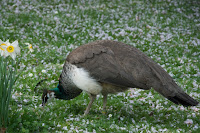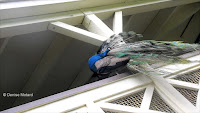INDIAN PEAFOWL
PEACOCK (pavo cristatus) – (See images below)
DESCRIPTION: The Indian peafowl is a large bird that is part of the Pheasant family. The male is mainly iridescent blue with white patches above and below the eye. It has a crest of fan-like blue feathers on the back of the crown. The upper mandible of the whitish bill is slightly curved downward. The wings are finely barred black and white. The lower back has an iridescent scaly pattern or blue, green and gold. The long tail coverts, a ‘train’, have multicolored ‘eyes’, and are loose and fluffy. The legs are long, strong and pink. The length of the male is around 45 inches (115 cm) long, NOT including the tail. With the tail the male length reaches some SEVEN FEET (2.13 meters) LONG!
Females have a grey head with white patches, an iridescent green-blue neck and throat and white breast. The rest of the body is grey brown, with the short tail darker. Females also have a crest of brown feathers on their head. Females are about three feet (one meter) long, including the tail.
VOICE: https://www.xeno-canto.org/explore?query=indian+peafowl
NAME: The bird we call ‘Peacock’ is the Indian Peafowl. It is also called the Common Peafowl and the Blue Peafowl. The name ‘Peacock’ is reserved for the male, the female is called ‘Peahen’ and the young are ‘Peachicks’. The name ‘Peacock’ dates back to the 1300s. The Latin genus name ‘Pavo’ stems from ‘pavane’, a slow dance used in processions and dating back from the Renaissance. This is in reference to the male display ritual. The species name ‘cristatus’ means ‘crested’, in reference to the bird’s crest.
HABITAT: Forest in its native range.
DIET: Omnivorous – insects, grubs, worms, seeds, grain, fruit, reptiles. In its native range the Indian peafowl can turn into a pest around agricultural areas.
BREEDING/NESTING: A male will have a group of several females. The male courtship is an extraordinary display of its tail feathers in a fan-like vertical semi-circle, which it shakes to attract a female while slowly walking around. The nest is a shallow depression on the ground in a well-sheltered area, but can also be built on a human-built structure. About 6 eggs are laid, incubated by the female only.
DISTRIBUTION: The Indian peafowl is native to India but because of the male extraordinary appearance and courtship display behavior, it has been introduced into many regions of the world. This includes Hawaii, where they were introduced in 1860.
CONSERVATION: The Indian peafowl is not considered as a species at risk due to its widespread range. This is in spite of the bird being hunted for its tail coverts, which are prized worldwide as an ornament. It is also hunted and domesticated for its meat. It is protected in India.
NOTES: The Indian peafowl is the national bird of India. This bird has an important cultural significance in India. It has been domesticated for millennia.
There are different theories trying to explain the extravagant tail plumage of the male. Most of the birds now in Hawaii are feral descendants and more or less on their own. Where introduced in urban or suburban areas, the Indian peafowl can turn into a nuisance because of its droppings, and its eating of garden flowers.
SIMILAR SPECIES: Green Peafowl
REFERENCES: https://en.wikipedia.org/wiki/Indian_peafowl
https://www.arkive.org/indian-peafowl/pavo-cristatus/
https://birdsna.org/Species-Account/bna/species/compea/introduction
http://www.torontozoo.com/ExploretheZoo/AnimalDetails.asp?pg=590
Some of the photos above are stills from this video below, where the male cleans its tail - quite a job!
DESCRIPTION: The Indian peafowl is a large bird that is part of the Pheasant family. The male is mainly iridescent blue with white patches above and below the eye. It has a crest of fan-like blue feathers on the back of the crown. The upper mandible of the whitish bill is slightly curved downward. The wings are finely barred black and white. The lower back has an iridescent scaly pattern or blue, green and gold. The long tail coverts, a ‘train’, have multicolored ‘eyes’, and are loose and fluffy. The legs are long, strong and pink. The length of the male is around 45 inches (115 cm) long, NOT including the tail. With the tail the male length reaches some SEVEN FEET (2.13 meters) LONG!
Females have a grey head with white patches, an iridescent green-blue neck and throat and white breast. The rest of the body is grey brown, with the short tail darker. Females also have a crest of brown feathers on their head. Females are about three feet (one meter) long, including the tail.
VOICE: https://www.xeno-canto.org/explore?query=indian+peafowl
NAME: The bird we call ‘Peacock’ is the Indian Peafowl. It is also called the Common Peafowl and the Blue Peafowl. The name ‘Peacock’ is reserved for the male, the female is called ‘Peahen’ and the young are ‘Peachicks’. The name ‘Peacock’ dates back to the 1300s. The Latin genus name ‘Pavo’ stems from ‘pavane’, a slow dance used in processions and dating back from the Renaissance. This is in reference to the male display ritual. The species name ‘cristatus’ means ‘crested’, in reference to the bird’s crest.
HABITAT: Forest in its native range.
DIET: Omnivorous – insects, grubs, worms, seeds, grain, fruit, reptiles. In its native range the Indian peafowl can turn into a pest around agricultural areas.
BREEDING/NESTING: A male will have a group of several females. The male courtship is an extraordinary display of its tail feathers in a fan-like vertical semi-circle, which it shakes to attract a female while slowly walking around. The nest is a shallow depression on the ground in a well-sheltered area, but can also be built on a human-built structure. About 6 eggs are laid, incubated by the female only.
DISTRIBUTION: The Indian peafowl is native to India but because of the male extraordinary appearance and courtship display behavior, it has been introduced into many regions of the world. This includes Hawaii, where they were introduced in 1860.
CONSERVATION: The Indian peafowl is not considered as a species at risk due to its widespread range. This is in spite of the bird being hunted for its tail coverts, which are prized worldwide as an ornament. It is also hunted and domesticated for its meat. It is protected in India.
NOTES: The Indian peafowl is the national bird of India. This bird has an important cultural significance in India. It has been domesticated for millennia.
There are different theories trying to explain the extravagant tail plumage of the male. Most of the birds now in Hawaii are feral descendants and more or less on their own. Where introduced in urban or suburban areas, the Indian peafowl can turn into a nuisance because of its droppings, and its eating of garden flowers.
SIMILAR SPECIES: Green Peafowl
REFERENCES: https://en.wikipedia.org/wiki/Indian_peafowl
https://www.arkive.org/indian-peafowl/pavo-cristatus/
https://birdsna.org/Species-Account/bna/species/compea/introduction
http://www.torontozoo.com/ExploretheZoo/AnimalDetails.asp?pg=590
 |
| Indian Peafowl head close up |
 |
| Indian peahen, Germany, by swoop1981 |
 |
| Peacock display, Thimindu-Goonatillake |
 |
| Indian peafowl, Waimea Valley, Oahu |
 |
| Indian peafowl self-preening, Oahu |
 |
| Indian peafowl back view, Oahu |
Some of the photos above are stills from this video below, where the male cleans its tail - quite a job!